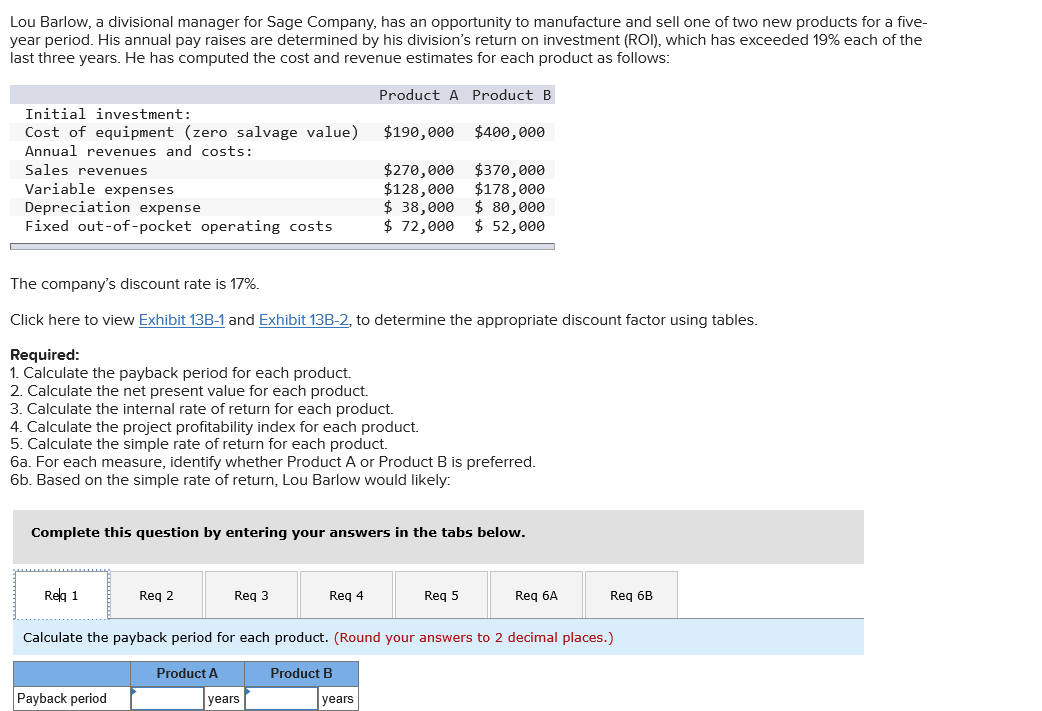






Lou Barlow, a divisional manager for Sage Company, has an opportunity to manufacture and sell one of two new products for a five- year period. His annual pay raises are determined by his division's return on investment (ROI), which has exceeded 19% each of the last three years. He has computed the cost and revenue estimates for each product as follows: Product A Product B $190,000 $400,000 Initial investment: Cost of equipment (zero salvage value) Annual revenues and costs: Sales revenues Variable expenses Depreciation expense Fixed out-of-pocket operating costs $270,000 $370,000 $128,000 $178,000 $ 38,000 $ 80,000 $ 72,000 $ 52,000 The company's discount rate is 17%. Click here to view Exhibit 13B-1 and Exhibit 13B-2, to determine the appropriate discount factor using tables. Required: 1. Calculate the payback period for each product. 2. Calculate the net present value for each product. 3. Calculate the internal rate of return for each product. 4. Calculate the project profitability index for each product. 5. Calculate the simple rate of return for each product. 6a. For each measure, identify whether Product A or Product B is preferred. 6b. Based on the simple rate of return, Lou Barlow would likely: Complete this question by entering your answers in the tabs below. Relg 1 Reg 2 Reg 3 Reg 4 Reg 5 Req 6A Reg 6B Calculate the payback period for each product. (Round your answers to 2 decimal places.) Product A Product B Payback period years years Reg 1 Reg 2 Reg 3 Reg 4 Reg 5 Reg 6A Reg 6B Calculate the net present value for each product. (Round your final answers to the nearest whole dollar amount.) Product A Product B Net present value Req 1 Reg 2 Relq3 Reg 4 Reg 5 Reg 6A Reg 6B Calculate the internal rate of return for each product. (Round your answers to 1 decimal place i.e. 0.123 should be considered as 12.3%.) Product A Product B Internal rate of return % % Reg 1 Reg 2 Reg 3 Reg 4 Reg 5 Reg 6A Reg 6B Calculate the project profitability index for each product. (Round your answers to 2 decimal places.) Product A Product B Project profitability index Reg 1 Reg 2 Reg 3 Req 4 Req 5 Reg 6A Req 6B Calculate the simple rate of return for each product. (Round your answers to 1 decimal place i.e. 0.123 should be considered as 12.3%) Product A Product B Simple rate of return Req 1 Reg 2 Reg 3 Reg 4 Reg 5 Rleq 6A Req 6B For each measure, identify whether Product A or Product B is preferred. Net Present Value Profitability Index Payback Period Internal Rate Simple Rate of of Return Return Reg 1 Req 2 Reg 3 Reg 4 Reg 5 Req 6A Req 6B Based on the simple rate of return, Lou Barlow would likely: Accept Product A Accept Product B OReject both products













